![]()
Spring, 2013 | The Middle East Quarterly, Volume XX: Number 2, pp. 65-71 | by Eyal Zisser

Syrian president Bashar al-Assad (center) with Mustafa Tlas (right) attend a ceremony at the unknown soldier monument in Damascus, October 6, 2003. The story of the Tlas family is illustrative of the turmoil afflicting Syria today. Tlas was the right-hand man of former President Hafiz al-Assad and defense minister for the younger Assad. But, Mustafa’s son, Abd al-Razzaq, has grown a Salafist beard and joined the revolt.
The outbreak of the Syrian revolution in March 2011 surprised many people. Until that time, it seemed that the 40-year reign of the Assad dynasty, at first under its founder, Hafiz, and then under his son and heir, Bashar, had succeeded in turning Syria into a strong and stable state with governmental institutions, military, and security forces. Even social and economic systems appeared quite sturdy and effective.
Yet a year and a half of bloody fighting between the regime and the rebels has undermined most of the achievements of the Assad dynasty and turned Syria into a failing state on the verge of disintegration. Most state institutions have ceased to function. The bonds that united the various religious and ethnic communities, tribes, and regions — that took many long years of hard work to forge — are rapidly unraveling. In addition, Syria has become a kind of punching bag with foreign actors, both regional and international, intervening freely in the country’s internal affairs.
How did the revolt spread so quickly to all parts of Syria, striking such deep roots among wide segments of the Syrian society? How has the Assad regime managed, for the time being and in contrast to other Arab regimes rocked by the recent upheavals, to survive the lethal challenges facing it? And how has it been able to maintain its cohesion and strength to the point where many observers do not preclude the possibility of its ultimate survival?
The Outbreak of the Syrian Revolution
The revolution in Syria, in contrast to the uprisings in Tunisia, Egypt, Libya, and Yemen, was at its base a peasants’ revolt, a protest by the Sunni periphery against what was perceived as the Baath regime’s turning its back on the country’s rural population. Only later did the rebellion take on additional dimensions with jihadists joining the struggle because of the regime’s “heretical” Alawite nature and because of its alliance with Shiite Iran and Hezbollah. In the name of jihad, thousands of volunteers have streamed into Syria from all over the Arab and Muslim world[1] though jihadist slogans probably did little to arouse Syrians to join the ranks of the revolution.
Revenge was another dimension that developed with time, stemming from the regime’s increasingly violent efforts to suppress the waves of protest. It is clear that the regime’s brutality served to expand the circle of participants in the revolution. Many who joined were motivated specifically by the desire to take revenge for the spilled blood of their family members and relatives or for the destruction of their home villages and towns by the regime’s forces.[2]
Paradoxically, in the past, the Sunni rural population had been one of the regime’s foremost mainstays. It was one of the main partners in Syria’s ruling coalition of minorities and the periphery, led by members of the Alawite community, who were in turn headed by the Assad dynasty. This coalition served as the basis for the Baath revolution of March 1963, and later as the basis of support for the “Corrective Movement” and for Hafiz al-Assad’s seizure of power in November 1970.
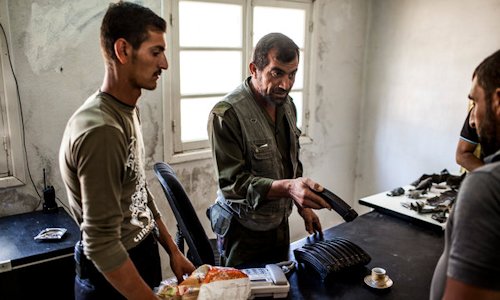
Majed al-Muhammad (center), a rebel commander, dispenses supplies to recruits. The revolution in Syria was at its base a peasants’ revolt, a protest by the Sunni periphery against what was perceived as the Baath regime’s turning its back on the country’s rural population. Only later did the rebellion take on additional dimensions with jihadists joining the struggle because of the regime’s “heretical” Alawite nature and its alliance with Shiite Iran and Hezbollah. (Photo: Bryan Denton/The New York Times)
With the passage of time and especially from the beginning of the 2000s, it seemed as if the Syrian regime had ceased reflecting Syrian society. The regime even seemed to have turned its back on the rural areas and the periphery. Beginning in 2006, Syria experienced one of the worst droughts the state had ever known with the damage felt most intensely in the Jazira region of northeastern Syria and in the south, especially in the Hawran region and its central city of Dar’a.
These regions were also adversely affected by the government’s new economic policies, which aimed at changing the character of the Syrian economy from a socialist orientation into a “social market economy.” The aim of these policies, led by Vice Prime Minister Abdullah Dardari, was to open Syria to the world economy, encourage foreign investment, and promote activity in the domestic private sector so as to ensure economic growth and enable the regime to cope with its domestic and economic challenges: rapid growth of the population, backward infrastructure and lack of advanced industry, over-reliance on agriculture, etc. The new policy was backed by Bashar al-Assad, who seemed to have underestimated the importance of the Baath party’s socialist ideology as well as its institutions and networking, mainly in the periphery. One conclusion to be drawn from the negative reactions to this policy in the periphery was that while the Syrian regime did indeed manage to preserve its image of strength and solidity during the first decade of the 2000s, its support base was considerably narrowed. It lost the broad popular support that it had enjoyed among the Sunni population in the rural areas and the periphery after it turned its back on them.[3]
And so, from the time the revolution broke out in March 2011 in the city of Dar’a, the rebellion spread like wildfire to all the rural areas and the periphery, including the northern part of the state, the Jazira region, and later, the agricultural towns of Homs and Hama. The revolution reached the large cities, Damascus and Aleppo, only at a much later stage.
The Tlas Family and the Town of Rastan
An illustration of this turmoil can be found in the story of the Tlas family from the small town of Rastan. Headed by Mustafa Tlas, the family was one of the pillars of the Baath regime, a living example of the close alliance between the regime and the Sunni periphery on the one hand, and between the Sunni and the Alawite officers led by the Assad dynasty on the other.
Rastan itself is the third largest town in the Homs district and numbers about 40,000 inhabitants according to a 2004 census. It is located on the main road between Aleppo and Damascus, on the segment between the towns of Homs and Hama, about 20 kilometers from Homs and 22 kilometers from Hama. Rastan’s residents earn their livings from agriculture and light industry, notably the rock quarries for which the town is known.[4]
The town has two main clans, the Hamdan, the larger and stronger of the two, and the Firzat. The Tlas family belongs to the Hamdan clan. One of the family’s members, Abdel Qadr Tlas, served as the mukhtar (administrative head) of Rastan from the end of the Ottoman period into the French Mandate period. As a young man, Mustafa Tlas, Abdel Qadr’s son, became the ally and right hand man of Hafiz al-Assad. The two met at the Homs Military Academy, during the officers’ course in which they were enrolled after joining the Syrian army in November 1952. They were roommates during the course, and their paths never parted thereafter. They advanced in rank together and, in November 1970, seized power in Damascus with Hafiz leading and Mustafa helping him. At that time, Tlas was serving as commander in chief of the army and was quickly appointed minister of defense, a post he held until his retirement in 2004.
Tlas was in office during the brutal suppression of the Islamist revolt against the Baath regime in 1976-82, which peaked with the massacre of the citizens of Hama in February 1982. His last task was, in essence, to help Assad’s son Bashar grow into his father’s big shoes.[5]
Tlas also established an economic empire. One of its showcases was a publishing house. He used this firm as a vehicle for publishing, in addition to works of other authors, his own “scholarly” writings, memoirs, and even poetry. Tlas married Lamya Jabiri, a member of the Aleppine aristocracy, and the couple had four children: two daughters — Nahid, who married a Saudi businessman and moved with him to Paris, and Sarya — and two sons — Firas, who became a successful businessman in Damascus, and Manaf, who chose a military career. Manaf was known as a close friend of Bashar al-Assad and served as a brigade commander in the Republican Guard Division, an elite unit formed to protect the regime.[6]
Rastan and the Start of the Revolt
In addition to being home to the Tlas family, Rastan also serves as a faithful reflection of the Sunni periphery. It is not surprising that when the Syrian revolution broke out, the town became one of the revolt’s focal points. As early as the beginning of April 2011, the town square statue of Hafiz al-Assad was reportedly smashed to pieces as demonstrators shouted with joy.[7] This was a symbolic act clearly expressing the town’s disengagement from the Baath regime and from the Assad dynasty. However, Rastan is too strategically located to be given up. Since it is on a main road linking northern and southern Syria and close to the towns of Homs and Hama, it became a major scene of bloody battles between the regime’s army and the insurgents, in which scores of the town’s residents were killed.
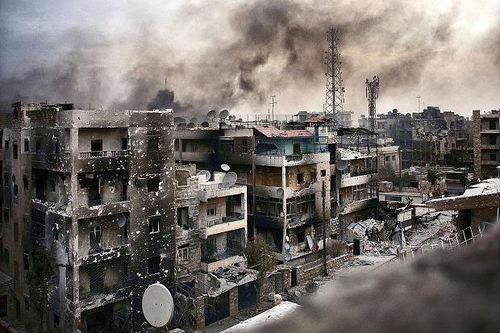
Bombed-out buildings in Aleppo, October 3, 2012, show the devastation perpetrated on civilians. The Assad regime’s brutal response to the revolt has only widened the circle of rebellion. Many who have joined the fighting are motivated by the desire to take revenge for the spilled blood of their relatives or the destruction of their homes and communities.
The protest movement in Rastan did not bypass the Tlas family. The members of the family who were officers and soldiers, like many of their friends and colleagues, could not ignore the pressure of the unfolding events or the fate suffered by their relatives, neighbors, and home town.
The first Tlas family member to join the revolt was Abd al-Razzaq Tlas, who announced his desertion from the regular Syrian army as early as June 2011. He has subsequently served as commander of the Faruq battalion associated with the Free Syrian Army, which operates in the region of Homs. As time passed, Abd al-Razzaq has become one of the closely watched symbols of the revolution. Thus, for example, innumerable interpretations were given to the fact that he has begun to grow a beard though this action did not necessarily stem from religious motives. His image was not damaged even after rumors were spread about his involvement in a sex scandal though he was apparently removed from his position as battalion commander.[8] Additional members of the Tlas family followed him into the revolution until finally, in the summer of 2012, the reverberations reached the home of Mustafa Tlas. This was quite late in the game and only after it began to seem as if the days of the Assad regime were numbered.
During the first months of 2012, Mustafa Tlas, suffering from health problems, moved to Paris to be near his daughter Nihad. His son Firas soon followed and established contacts with opposition figures and began participating in resistance events abroad.[9] At the beginning of July 2012, Manaf announced his defection from the ranks of the regime. In an interview with al-Arabiya news network, he explained, “I do not see myself as a senior figure in the ranks of the regime but rather as one of the sons of the Syrian Arab army who opposes barbarism and murder of innocents and the corrupt government … I hope for the establishment of a united Syria and for its rebuilding as a state that does not believe in or promote revenge, discrimination, or selfishness.”[10] Immediately after Manaf’s defection, several opposition figures began to mention him as a possible leader of Syria after Bashar’s hoped-for fall. Other opposition figures, however, came out firmly against the idea.[11]
The steps taken by those members of the Tlas family serve as a graphic example of what was happening all over Syria during the past year and a half. They are good indicators of how people who had been strong supporters of the Assad regime turned their backs on it when they felt that it had betrayed them or no longer served their interests.
The Survival of the Regime
Every coin and almost every story has two sides, and so it is with the story of Syria. One side of the story has to do with the fact that the insurgents’ uprising spread quickly and struck deep roots. The other side of the story has to do with the regime and the undeniable fact that it has so far been able to survive. One explanation for this focuses on the built-in weaknesses of the opposition,[12] which is a faithful reflection of the Syrian society: Both opposition and society suffer from divisions and fragmentation based upon ethnic, religious, regional, socioeconomic, and other differences. Another explanation focuses on the international community’s lack of will or ability to intervene in Syria. A third explanation highlights the sources of the regime’s strengths, calling attention to the fact that the regime survives, not only because of its opponents’ weaknesses, but also because of the reserves of power at its disposal.
One source of the regime’s strength lies in the support it receives from the members of the minority communities, who serve as its social bases. These include the Alawites (12 percent of the population), the Druze (5 percent), and most of the Christians (13 percent). The Kurds (10 percent), including those who live in the regions bordering Turkey and Iraq, have for the most part, not turned against the government either. Many Kurds have exploited the revolution to throw off government control and advance the cause of partial Kurdish independence. Nevertheless, the Syrian Kurds as a whole have refrained from joining the ranks of the opposition or coming out openly against the Assad regime.
Another source of regime strength lies in the fact that while turmoil has come to the suburbs and the slums of Aleppo and Damascus, the revolution has not ignited among urban Syrians, including the Sunni bourgeoisie of the big cities. Most big city residents have chosen to remain on the sidelines and not support the protests, fearing that this leap would result in political instability, as happened in Iraq or Lebanon, at immense costs.
Part of the reluctance stems from the economic benefits the urban bourgeoisie enjoy, especially during recent years thanks to the regime’s economic policies. Some have to do with the bourgeoisie’s age-old resentments, reservations, and aversion toward the periphery and the rural regions and their inhabitants. The numbers of urban dwellers are considerable. Some 55.7 percent of Syrians live in cities. Around 8 million (out of the total population of 23 million) live in the country’s three large cities: Aleppo — 2.98 million; Damascus — 2.52 million; and Homs — 1.27 million. Most of the Christians live in these three cities.[13]
Since most opposition activists come from rural areas, most incursions into the big cities, including Damascus, Aleppo, and Homs, have been carried out by insurgents from nearby rural regions. They penetrate the big cities mostly through the slum neighborhoods and suburbs, which are often inhabited by recent migrants from the periphery and rural areas. These migrants generally maintain connections with relatives back home, and it is from there that the armed bands come. But because the bourgeoisie of Damascus and Aleppo have refrained from joining the insurgents,[14] the Syrian opposition has been denied victory photos such as those from Cairo’s Tahrir Square, which made it clear that the die had been cast in Egypt and that the youth were on the revolution’s side. In Syria, for the time being, the youth in the big cities prefer to remain shut up in their homes.
Another source of the regime’s strength lies in the loyalty of its institutions, in particular, the army, the security apparatuses, the state bureaucracy, and the Baath party apparatuses. Indeed, in many cases, using the party’s networks, the regime was able to recruit and mobilize local families in various areas, including Sunni neighborhoods, which have become local militias fighting for the regime. These include members of the Sunni community in particular with the emphasis on the Sunni periphery.
Loyalists in Rastan
Returning to Rastan, it is clearly not a big city but of the rebel periphery. But it is also undisputable that many of its residents remain loyal to the regime. In the Tlas family, some have joined the ranks of the rebels, but others maintain neutrality, and still others continue to work for the government. Thus, Talal Tlas serves as Syria’s deputy minister of defense and Ahmad Tlas serves as the commander of the First Corps, the most important military unit in southern Syria.[15] And the various branches of the Tlas family continue to live together in Rastan; battles in the town take place between rebels and army forces that come from outside in order to attack.[16]
Beside these two senior Tlas members, there are others still serving loyally as army officers, perhaps because they consider this to be in their best personal interest and a good way to advance their careers. Their position is quite different from that of the younger officers, like Abd al-Razzaq Tlas, who has his whole future before him. Joining the ranks of the revolution promises him a brilliant future should it succeed. In any case, as a young officer, he did not have nearly as many vested interests to leave behind and potentially lose. The situation of the senior and middle level officers is much different. They could lose everything, all their achievements, their ranks, pensions, possibilities for further advancement, and other benefits and privileges. Joining the revolution means sacrifice for a vague future full of unknowns. The revolutionary future holds out the promise of great rewards for the youth, but not necessarily for the symbols of the old regime.
It is clear that as long as the members of the Tlas family and people like them give the regime their support, it will be able to survive. Only about 10 percent of the army’s manpower has defected. The other 90 percent, both soldiers and officers, the great majority of whom come from the Sunni periphery, continues to stand united around the regime, giving it the breathing space it so desperately needs.
Conclusions
The story of the Tlas family and their town, Rastan, attests to the complexity of the Syrian picture. The regime is losing blood daily; little by little support for it diminishes. Since the eruption of the revolution, the trend has clearly been in one direction only. Nevertheless, the regime retains reserves of support that enable it to survive. A dramatic shift in the situation, such as Bashar’s assassination or an unexpected intervention by the international community, could give the insurgents the push they need and bring about a major change in the course of the conflict. But the example of the Tlas family and Rastan suggests that the struggle for Syria will still take a long time to unfold.
Eyal Zisser is dean of the faculty of humanities and the Yona and Dina Ettinger Chair of Contemporary Middle Eastern History at Tel Aviv University.
![]()
Notes:
[1] The New York Times, Oct. 14, 2012; Al-Monitor, online news, Oct. 18, 2012.
[2] Fouad Ajami, The Syrian Rebellion (Stanford: Stanford University, 2012), pp. 69-156.
[3] Eyal Zisser, “The Renewal of the ‘Struggle for Syria’: The Rise and Fall of the Ba’th Party,” Sharqiya, Fall 2011, pp. 21-9; Hanna Batatu, Syria’s Peasantry: The Descendants of Its Lesser Rural Notables and Their Politics (Princeton: Princeton University Press, 1999), pp. 131-75. For economic data, “Syria—Country Report,” Economist Intelligence Unit, Apr. 2011.
[4] The Annual Report for 2004, Central Bureau of Statistics, Prime Minister’s Office, Syrian Arab Republic, Damascus; “Syria: Mining,” Encyclopedia of the Nations, accessed Dec. 7, 2012.
[5] Mustafa Tlas, Mira’t Hayati (Damascus: Dar Tlas lil-Nashr, 1995), vol. 1, pp. 240-310; Sami Moubayed, Steel and Silk, Men and Women Who Shaped Syria, 1900-2000 (Seattle: Cune Press, 2006), pp. 89, 255.
[6] Al-Hayat (London), July 12, 2012; al-Jazeera TV (Doha), July 14, 2012.
[7] Asharq al-Awsat (London), Apr. 7, 2011; al-Arabiya TV (Dubai), Apr. 6, 7, 2011.
[8] Reuters, June 6, 7, 2011; al-Jazeera TV, June 6, 2011; BBC Radio in Arabic, Feb. 12, 2012; Aron Lund, “Holy Warriors: A Field Guide to Syria’s Jihadi Groups,” Foreign Policy, Oct. 15, 2012.
[9] Al-Quds al-Arabi (London), June 28, 2012; al-Jazeera TV, July 1, 2012.
[10] Reuters, July 14, 2012; al-Arabiya TV, July 24, 2012.
[11] Al-Hayat, July 19, 24, 2012.
[12] See, for example, BBC News, Nov. 12, 2012; Itamar Rabinovich, “The Anarchy Factor in Syria,” The Straits Times (Singapore), May 3, 2012.
[13] “General Census,” Central Bureau of Statistics, Prime Minister’s Office, Syrian Arab Republic, Damascus, accessed Dec. 21, 2012.
[14] Reuters, July 18, 19, 2012; al-Hayat, Aug. 23, 2012.
[15] Syrian TV-24, Aug. 1, 2012.
[16] “Al-Markaz al-I’lami fi Rastan,” YouTube.com, July 22, 25, 2012.



 RSS
RSS

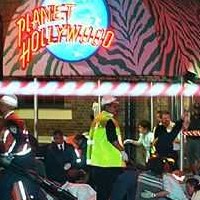


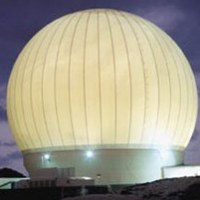
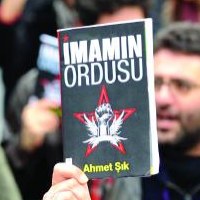




Latest Comments
Hello Mike, Thank you for your positive feedback to the article. I felt there wasn’t too much critical analysis of ...
Thanks for this considered and well constructed article. A follow up article on the manner in which the editorial contro...
THE CLUELESSNESS OF CLAIMING THAT OBAMA'S MIDDLE EAST POLICIES WERE A FAILURE CANNOT BE FURTHER FROM THE TRUTH, WHAT THE...
As long as Obama is the president of the usa do not trust the us government......
Thank you for an good read....